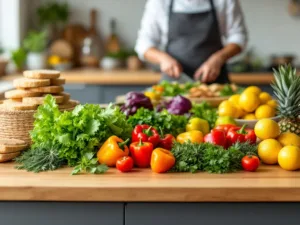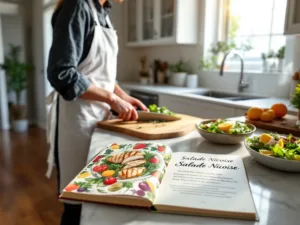High-Protein Foods That Can Be Cooked Healthily: A Comprehensive Guide to Nutritious and Delicious Meals
Introduction
In today’s health-conscious world, protein has become a cornerstone of nutrition. Whether you’re an athlete aiming to build muscle, a busy professional seeking sustained energy, or someone simply looking to maintain a balanced diet, incorporating high-protein foods into your meals is essential. However, not all protein sources are created equal, and how you prepare them can significantly impact their nutritional value. This article delves into the world of high-protein foods, exploring how to cook them healthily to maximize their benefits. From lean meats and plant-based options to dairy and seafood, we’ll provide practical tips, recipes, and insights to help you create nutritious, protein-packed meals that are as delicious as they are good for you.
Why Protein Matters: The Building Blocks of Life
Protein is one of the three macronutrients, alongside carbohydrates and fats, that our bodies need in large amounts. It plays a critical role in building and repairing tissues, producing enzymes and hormones, and supporting immune function. For those looking to lose weight, protein is particularly valuable because it promotes satiety, helping you feel full longer and reducing the likelihood of overeating.
The Recommended Dietary Allowance (RDA) for protein is 0.8 grams per kilogram of body weight for the average adult. However, this amount can vary based on factors such as age, activity level, and health goals. Athletes, pregnant women, and older adults, for example, may require more protein to meet their needs.
High-Protein Foods: A Diverse Palette of Options
When it comes to high-protein foods, the options are vast and varied. Below, we’ll explore some of the best sources of protein and how to cook them healthily.
1. Lean Meats: Chicken, Turkey, and Lean Beef
Lean meats are among the most popular high-protein foods, offering a complete source of protein that contains all nine essential amino acids.
- Chicken Breast: A 3-ounce serving of cooked chicken breast provides about 26 grams of protein. To keep it healthy, opt for grilling, baking, or poaching instead of frying. Season with herbs and spices rather than heavy sauces.
- Turkey: Turkey is another excellent lean meat, with a similar protein content to chicken. Try making turkey burgers or adding ground turkey to soups and stews.
- Lean Beef: Cuts like sirloin or tenderloin are lower in fat and high in protein. Stir-frying with vegetables or slow-cooking in a broth-based stew are healthy cooking methods.
Practical Tip: Remove visible fat and skin from meats before cooking to reduce saturated fat content.
2. Seafood: Fish and Shellfish
Seafood is not only rich in protein but also provides essential omega-3 fatty acids, which are beneficial for heart health.
- Salmon: A 3-ounce serving of salmon contains about 22 grams of protein. Baking or grilling salmon with a drizzle of olive oil and lemon juice is a simple and healthy preparation method.
- Tuna: Canned tuna is a convenient and affordable protein source. Mix it with Greek yogurt instead of mayonnaise for a healthier tuna salad.
- Shrimp: Shrimp is low in calories and high in protein, making it a great addition to salads, stir-fries, or pasta dishes.
Practical Tip: Avoid breading and deep-frying seafood, as this adds unnecessary calories and unhealthy fats.
3. Plant-Based Proteins: Legumes, Tofu, and Tempeh
For vegetarians and vegans, plant-based proteins are a vital part of the diet. They are also an excellent option for anyone looking to reduce their meat consumption.
- Lentils: One cup of cooked lentils provides about 18 grams of protein. Use them in soups, salads, or as a meat substitute in tacos.
- Chickpeas: Chickpeas are versatile and can be roasted for a crunchy snack or blended into hummus.
- Tofu and Tempeh: These soy-based products are rich in protein and can be marinated and grilled, stir-fried, or baked.
Practical Tip: Combine plant-based proteins with whole grains, such as brown rice or quinoa, to create a complete protein source.
4. Dairy and Eggs: Nutrient-Dense Protein Sources
Dairy products and eggs are not only high in protein but also provide essential vitamins and minerals like calcium and vitamin D.
- Greek Yogurt: With about 10 grams of protein per 100 grams, Greek yogurt is a fantastic breakfast or snack option. Add fresh fruit and a drizzle of honey for sweetness.
- Cottage Cheese: Cottage cheese is a low-calorie, high-protein food that can be eaten on its own or used in recipes like pancakes or muffins.
- Eggs: Eggs are a complete protein source and incredibly versatile. Boil, scramble, or poach them for a healthy meal.
Practical Tip: Choose low-fat or fat-free dairy options to reduce saturated fat intake.
5. Nuts and Seeds: Protein-Packed Snacks
Nuts and seeds are not only high in protein but also provide healthy fats and fiber.
- Almonds: A handful of almonds (about 23 nuts) contains 6 grams of protein. Enjoy them as a snack or sprinkle them over salads.
- Chia Seeds: These tiny seeds are a great addition to smoothies, oatmeal, or yogurt, offering about 4 grams of protein per two tablespoons.
- Pumpkin Seeds: Roasted pumpkin seeds make a delicious and protein-rich topping for soups and salads.
Practical Tip: Be mindful of portion sizes, as nuts and seeds are calorie-dense.
Healthy Cooking Methods for High-Protein Foods
How you cook your high-protein foods can make a significant difference in their nutritional profile. Here are some healthy cooking methods to consider:
1. Grilling and Broiling
Grilling and broiling allow excess fat to drip away from the food, making them ideal for lean meats and fish. Use a marinade made with olive oil, lemon juice, and herbs to enhance flavor without adding extra calories.
2. Baking and Roasting
Baking and roasting are excellent for cooking large cuts of meat or preparing protein-rich casseroles. Use a wire rack to elevate the food and prevent it from sitting in its own fat.
3. Steaming and Poaching
These methods are perfect for delicate proteins like fish and eggs. Steaming preserves nutrients, while poaching in water or broth adds moisture without extra fat.
4. Stir-Frying
Stir-frying is a quick and healthy way to cook protein with vegetables. Use a small amount of healthy oil, such as olive or avocado oil, and focus on fresh ingredients.
5. Slow Cooking
Slow cooking is ideal for tougher cuts of meat, as it breaks down connective tissue and results in tender, flavorful dishes. Use broth or water as the cooking liquid to keep it healthy.
Sample Recipes: Healthy High-Protein Meals
To inspire your culinary creativity, here are two simple and healthy recipes featuring high-protein foods:
1. Grilled Lemon Herb Chicken
Ingredients:
- 4 boneless, skinless chicken breasts
- 2 tablespoons olive oil
- Juice of 1 lemon
- 2 cloves garlic, minced
- 1 teaspoon dried oregano
- Salt and pepper to taste
Instructions:
- In a bowl, whisk together olive oil, lemon juice, garlic, oregano, salt, and pepper.
- Marinate the chicken breasts in the mixture for at least 30 minutes.
- Preheat the grill to medium-high heat.
- Grill the chicken for 6-7 minutes per side, or until the internal temperature reaches 165°F (74°C).
- Serve with a side of steamed vegetables or a fresh salad.
2. Lentil and Vegetable Stir-Fry
Ingredients:
- 1 cup cooked lentils
- 1 cup mixed vegetables (e.g., bell peppers, broccoli, carrots)
- 1 tablespoon olive oil
- 2 cloves garlic, minced
- 1 tablespoon soy sauce
- 1 teaspoon sesame seeds (optional)
Instructions:
- Heat olive oil in a large skillet or wok over medium heat.
- Add garlic and sauté for 1 minute.
- Add the mixed vegetables and stir-fry for 5-7 minutes, until tender-crisp.
- Stir in the cooked lentils and soy sauce, heating through.
- Sprinkle with sesame seeds before serving.
Conclusion: Making High-Protein Foods a Healthy Staple
Incorporating high-protein foods into your diet doesn’t have to be complicated or time-consuming. By choosing lean meats, seafood, plant-based options, and dairy, and employing healthy cooking methods, you can create meals that are both nutritious and delicious. Remember to balance your protein intake with plenty of fruits, vegetables, and whole grains to ensure a well-rounded diet.
Whether you’re looking to build muscle, lose weight, or simply eat healthier, high-protein foods offer a versatile and satisfying way to meet your nutritional goals. So, fire up the grill, dust off your slow cooker, and start experimenting with the endless possibilities of healthy, protein-packed meals. Your body—and your taste buds—will thank you!









Add comment